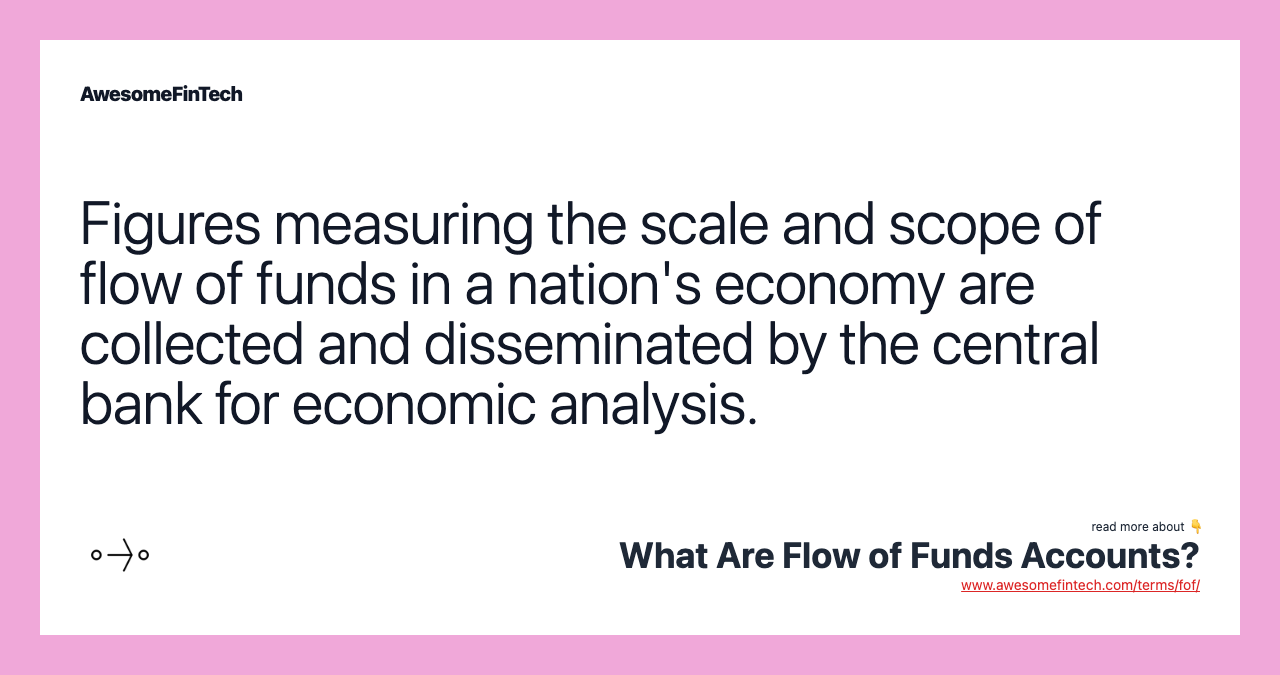What Are Flow of Funds Accounts?
Flow of funds (FOF) are financial accounts that are used to track the net inflows and outflows of money to and from various sectors of a national economy. The data from the FOF accounts can be compared to prior data to analyze the financial strength of the economy at a certain time and to see where the economy may go in the future. A wide range of financial instruments is accounted for: Treasury assets, American deposits abroad, savings deposits, money market funds, pension funds, corporate equities and bonds, mutual fund shares, mortgages, and consumer credits are just a few examples. Flow of funds (FOF) are financial accounts that are used to track the net inflows and outflows of money to and from various sectors of a national economy. Flow of funds (FOF) are national financial accounts that track the movement of money among industries or sectors of the economy.

More in Economy
What Are Flow of Funds (FOF)?
Flow of funds (FOF) are financial accounts that are used to track the net inflows and outflows of money to and from various sectors of a national economy. Macroeconomic data from flow of funds accounts are collected and analyzed by a country's central bank. In the United States, this data is released by the Federal Reserve Bank approximately 10 weeks after the end of each quarter.
Note that a different term "fund flows" is used to denote the amount of assets moving in and out of different types of mutual funds, e.g. among equity and fixed income funds.



Understanding Flow of Funds Accounts
The FOF accounts are used primarily as an economy-wide performance indicator. The data from the FOF accounts can be compared to prior data to analyze the financial strength of the economy at a certain time and to see where the economy may go in the future. The accounts can also be used by governments to formulate monetary and fiscal policy.
The accounts use double-entry bookkeeping to track the changes in assets and liabilities in all sectors of the economy: households, nonprofit organizations, corporations, farms, the government (federal, state and local) and the foreign sector. A wide range of financial instruments is accounted for: Treasury assets, American deposits abroad, savings deposits, money market funds, pension funds, corporate equities and bonds, mutual fund shares, mortgages, and consumer credits are just a few examples.
The Fed's annual flow of funds data extends back to 1945, with quarterly data available from the beginning of 1952. The data provide a nuanced picture of how the size and composition of the U.S. economy have changed since World War II.
Flow of Funds Data
The Fed issues reports on the financial accounts of the U.S. on a trailing quarterly basis, including data on flow of funds. The release, which the Fed labels Z.1, shows the assets and liabilities of each sector of the economy at the end of the period in question. It also shows how each sector has served as a source and use of funds. It includes a times series of outstanding debt for each sector of the economy, the derivation of net wealth in the country by asset, and the distribution of gross domestic product (GDP). Detailed statements for each account show how net capital has shifted to or from various sectors, allowing for a granular look at the movement of funds within the economy, as well as into and out of it.
Related terms:
Bureau of Economic Analysis (BEA)
The Bureau of Economic Analysis (BEA), a division of the U.S. Department of Commerce, is responsible for the analysis and reporting of economic data. read more
Brexit (British Exit from the European Union)
Brexit refers to the U.K.'s withdrawal from the European Union after voting to do so in a June 2016 referendum. read more
Capital Account
In economics, the capital account is the part of the balance of payments that records net changes in a country’s financial assets and liabilities. read more
Double Entry
Double entry is an accounting term stating that every financial transaction has equal and opposite effects in at least two different accounts. read more
Federal Reserve System (FRS)
The Federal Reserve System is the central bank of the United States and provides the nation with a safe, flexible, and stable financial system. read more
Fiscal Policy : Types & Tools
Fiscal policy uses government spending and tax policies to influence macroeconomic conditions, including aggregate demand, employment, and inflation. read more
Fund Flow
Fund flows are the net cash that went into or out of specified funds, assets, sectors, or other market categories. read more
Gross Domestic Product (GDP)
Gross domestic product (GDP) is the monetary value of all finished goods and services made within a country during a specific period. read more
Inflation
Inflation is a decrease in the purchasing power of money, reflected in a general increase in the prices of goods and services in an economy. read more
Monetary Policy
Monetary policy is a set of actions available to a nation's central bank to achieve sustainable economic growth by adjusting the money supply. read more